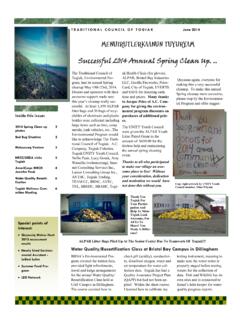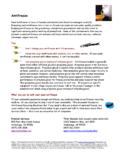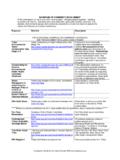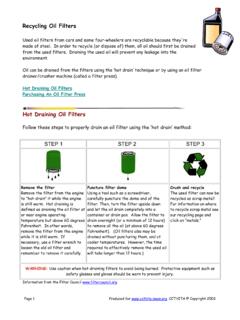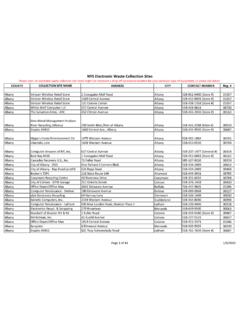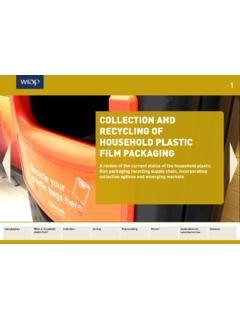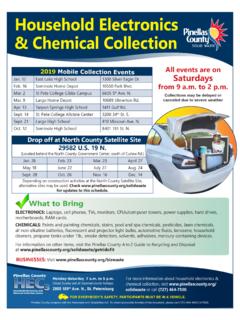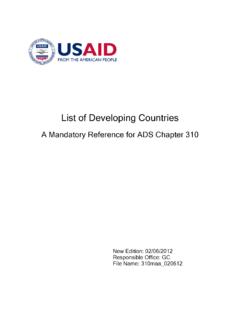Transcription of HOUSEHOLD BATTERY COLLECTION
1 HOUSEHOLD BATTERY COLLECTION . How dangerous are small HOUSEHOLD batteries in your landfill? Like most environmental risk questions, that depends on a number of factors: Factor # 1: Which metal? Source: USEPA at hw/ One factor is which chemical/metal that the BATTERY contains. Since 1996, mercury has been phased out of most small batteries made in the (and Canada as well). Because the metals that are present are not considered to be highly toxic, Carbon-Zinc and non-button Alkaline batteries aren't even officially considered hazardous wastes anymore.
2 Regular alkaline batteries are the most common HOUSEHOLD BATTERY and include AA, AAA, C, D, 9 volt, and lantern type batteries. Note though, just because a BATTERY looks like, or is an AA (or other), it doesn't mean that it is definitely alkaline. You have to look at the packaging or label. And if you burn your wastes, even alkalines will still emit heavy metals into the smoke. In contrast, Button cell batteries still contain mercury. Button cell batteries may be alkaline, silver oxide, or zinc air, and all types contain significant amounts of mercury.
3 Mercuric oxide batteries, which contain by far the most mercury, can come in different shapes and sizes, but are now mostly for industrial and medical use. Then Nickel-Cadmium (NiCad), Lithium Ion, and Small Sealed Lead batteries (SSL's) also contain metals that can be very harmful to the health of humans and wildlife. Cadmium, lithium, lead, and mercury are all toxic metals. These metals are in batteries for watches, cameras, calculators, hearing aids, electronic greeting cards, clocks, electronic games, motorized toys, etc. Some rechargeable NiCads and are the same shape, and are meant to be used as regular AA, AAA, C, D, etc.
4 Batteries. Some sealed lead batteries may look like alkaline 6 or 9-volt batteries and NiCad's can look like regular alkalines, but they are very different because their contents are much more toxic. Some cell-phone and other hi-tech electronic batteries still contain mercury. But these batteries, regardless of where they are made, are required to include instructions and contact information about where to recycle or dispose them. An example of NiCad rechargeable AA batteries How Can You Tell What The BATTERY Is? The BATTERY Act of 1996 requires Ni-Cad and most small sealed lead batteries to be labeled.
5 Remember, all button batteries have mercury, so you don't need to strain your eyes! Canadian batteries should be labeled as well, either on the BATTERY or consumer package. Labeling for other foreign batteries varies. Beware that many are more likely to contain mercury or other toxic metals. Page 1 Developed by Zender Environmental , Funded by Institute of Tribal Environmental Professionals & Ak Forum USDA Rural Dev Program, Copyright 2008. Factor #2: Landfill practices What happens to the trash after it reaches the dump is another factor to consider.
6 If you have an unlined dump (which most Villages do), those chemicals have a potential for migrating outside your dump and into your environment. If your community wastes are burned, the likelihood of those metals reaching beyond the dumpsite (in the smoke) is very high. In a Lower 48 study, it was estimated that 35 percent of all background local-source mercury comes from incinerating batteries with HOUSEHOLD garbage. Factor #3: Quantity Another factor to consider is the quantity that is being generated how much toxic metal can potentially get into the water, air, and food chain?
7 We don't know the exact contribution of each BATTERY -type to a Village waste stream. But we can tell you the national average of used HOUSEHOLD BATTERY generation each year is about 2 lbs per HOUSEHOLD . We haven't heard of any detailed Village counts so we don't know if Villages average more or less. Most of the weight of those batteries are probably regular alkaline batteries. Some batteries have toxic metals, but in a very, Button cell batteries. Source: Environment Canada at very small amount. This doesn't mean that you shouldn't recycle them, but it does mean that it is okay to take some time to build up a program where they are all sent out of the Village.
8 Factor #4: Comparison of where you will do the most good When you think about quantity, it is good to consider the particular metal amount compared with other sources of these metals. For example, getting all vehicle and large emergency power lead-acid batteries out of the dump and waters ( marine batteries discarded in the River) will reduce lead in your environment more than collecting all of the HOUSEHOLD batteries containing lead. An annual Village average for vehicle lead-acid batteries is about 10 to 15 lbs per person, and of that weight, most of it is very harmful (either lead or acid).
9 To read about some other village HOUSEHOLD waste lead sources, see our other lead sources handout at further below. With mercury, there is a slightly different story. Mercury is also a very harmful metal, especially if it changes to its most toxic form, called methylmercury . It can hurt brain development in children and affect neurological ability in adults ( being able to move well and remember or understand things). There can be many sources of mercury in the community. Mercury switches in and old thermometers are of particular concern as they are much, much Page 2 Developed by Zender Environmental , Funded by Institute of Tribal Environmental Professionals & Ak Forum USDA Rural Dev Program, Copyright 2008.
10 Higher in mercury than batteries, even though they may not be discarded as often. See our Local mercury sources handout at to decide if you can start a separation program for high-mercury containing waste types. Regardless of their mercury content, two of the easiest and most common mercury sources to do something about in regular Village trash are fluorescent lights and button cell batteries. In regular HOUSEHOLD trash, most of the mercury these days is from button cell batteries. Button cell batteries don't weigh much, and last a fair amount of time, but they can contain about 25 mg of mercury each.
